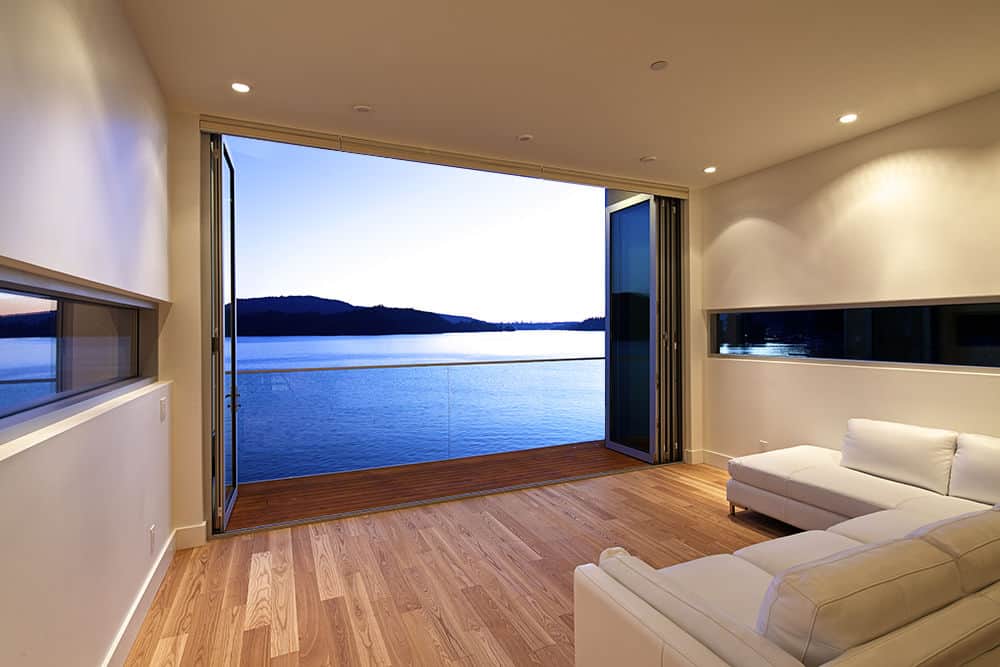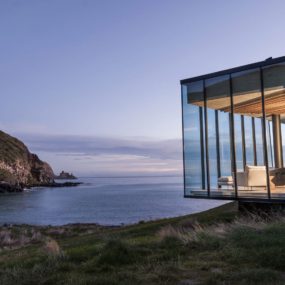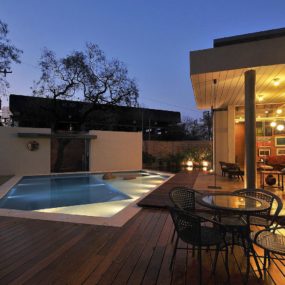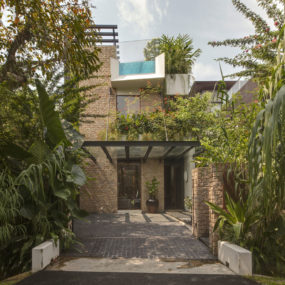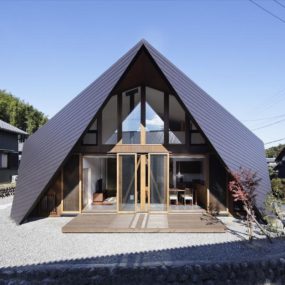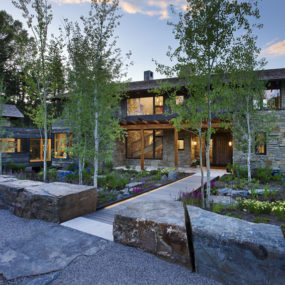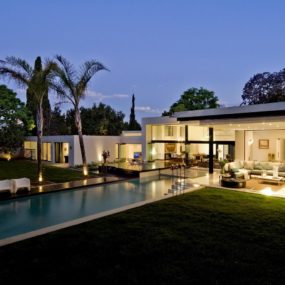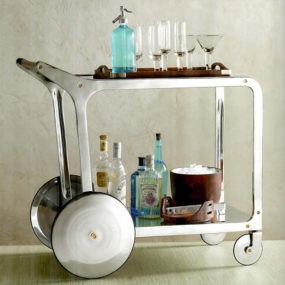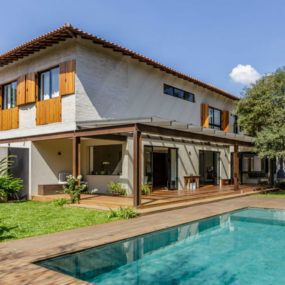
Built in a geographically challenging location in northwestern Mexico, this impressive house by P+0 Architectura blends influences of mountain and desert climes, integrating them both into a contemporary and luxurious package. From afar, the residence appears to rise only mildly from the mountainside, but the true scope of its construction is revealed as you venture closer and closer. With respect given to the nature around it, the dwelling is cantilevered at multiple points above the slopes, creating impressive views for miles around. The house is clad in concrete, but is painted in a manner which invokes a natural, weather-worn environment. Additionally, rough stone is used for outdoor recreational areas and property walls, invoking tradition and nature within the context of an undeniably modern dwelling.
Within the home, two functional stories have been created (with a rooftop deck above them all). The main floor is the most impressive, featuring all the house’s public rooms and its master suite. The hallways inside are arranged in an X-shaped pattern, with every room and passageway allowed window space to bring in natural light and feature impressive views. The main living spaces and master bedroom both blend traditional Mexican furnishings with new designs, reflecting that same blend in the house’s shape as a whole. While the rust-hued walls seen outside are continued in most areas of the interior, at time the concrete is left unpainted for certain effect in rooms like the kitchen and bathroom.
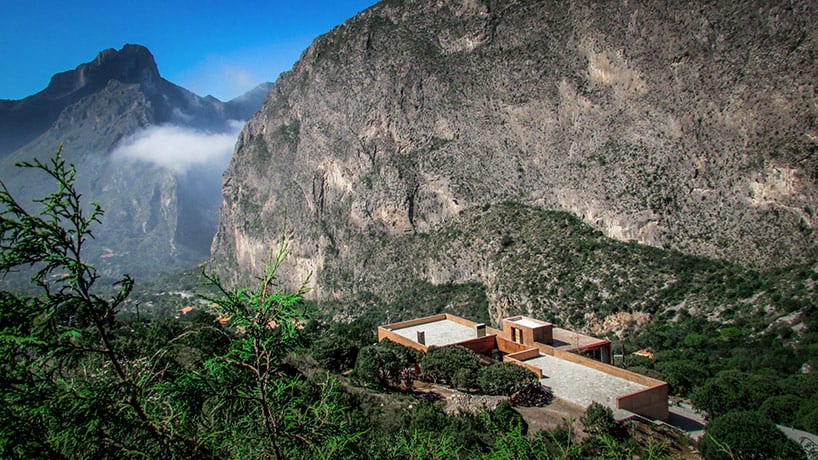
The house occupies a spectacular location, tucked on a forested downslope between massive Mexican mountain ridges. It features stunning views of the rocks rising above and valley broadening out below, but is protected from the harshest mountaintop weather by being between slopes instead of situated on the crest of a range.
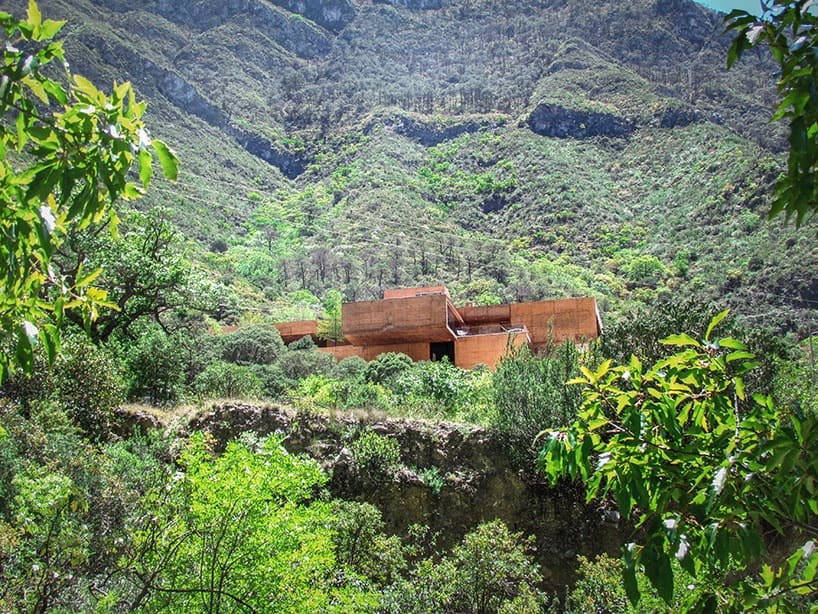
From all angles below, the house seems to grow naturally out of the hillside, with no visible trace of the road leading up to the building or any supporting structures aside from the mountain itself. The worn-down natural browns of the home’s exterior help to blend it into the slope as well, respecting the surrounding environment.
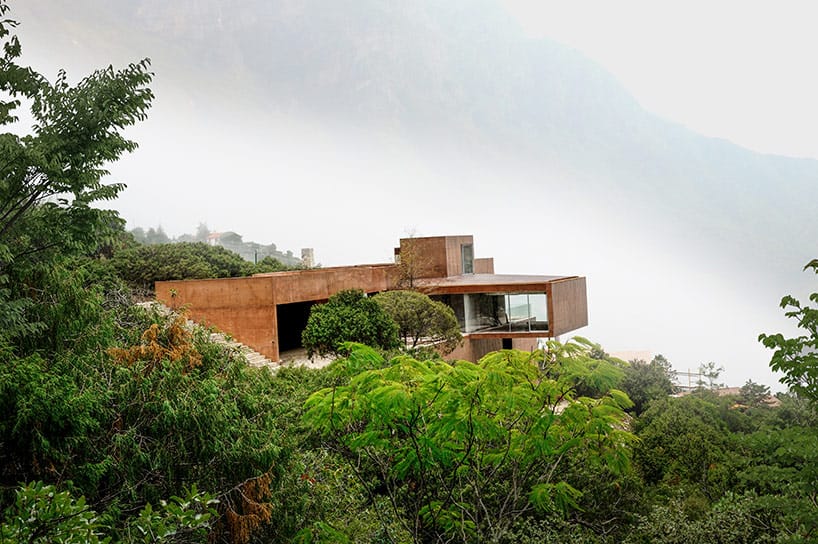
As you approach the home from the rear, a more distinct shape for its living spaces becomes apparent. So, too, do the steps running between different levels of the home on the outside, in line with the landscape. The rust-colored house may be beautifully integrated into its surroundings, but no sacrifices have been made in its residential usability to achieve that effect.
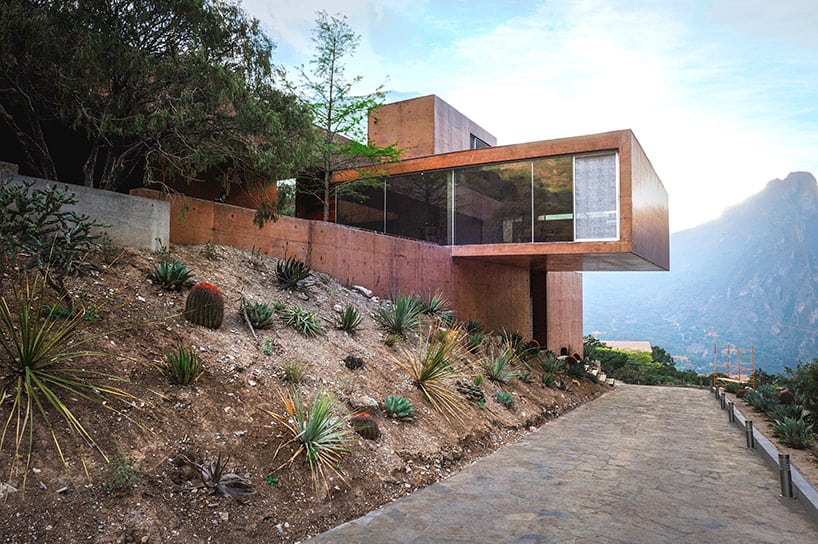
At the side and front of the dwelling, a number of rooms are cantilevered over the landscape, maximizing unhindered views and adding floorspace while preserving the surrounding greenery.
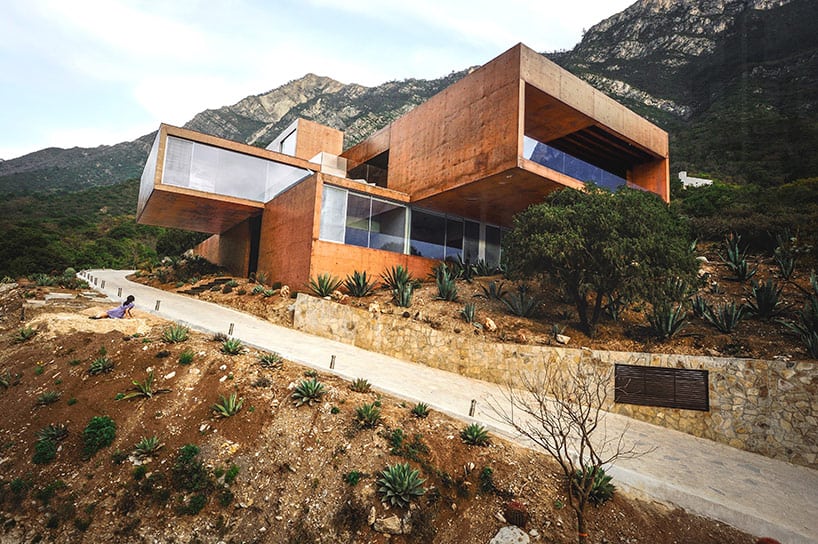
The home appears largest from underneath its front facade, where three distinct window areas are set at different depths with views of the valley. A few decks are built into the front as well, with glass railings to ensure panoramic views.
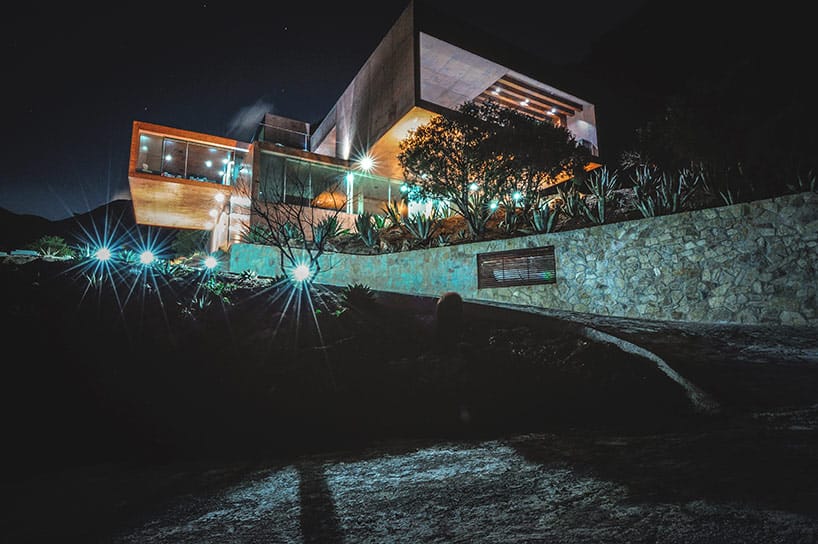
At night, bright spot lighting illuminates the building at key points while keeping its natural tones subdued. At this time of day, the house appears its most thoroughly modern, with a greyed-out color palette and light streaming from its property.

At the end of the home’s driveway, a stone extension forms a walkway leading in towards the house’s main entrance, set in a courtyard underneath the roofline but not enclosed by walls. A set of steps on the side leads up towards rooftop decks and a top-floor roof entrance.
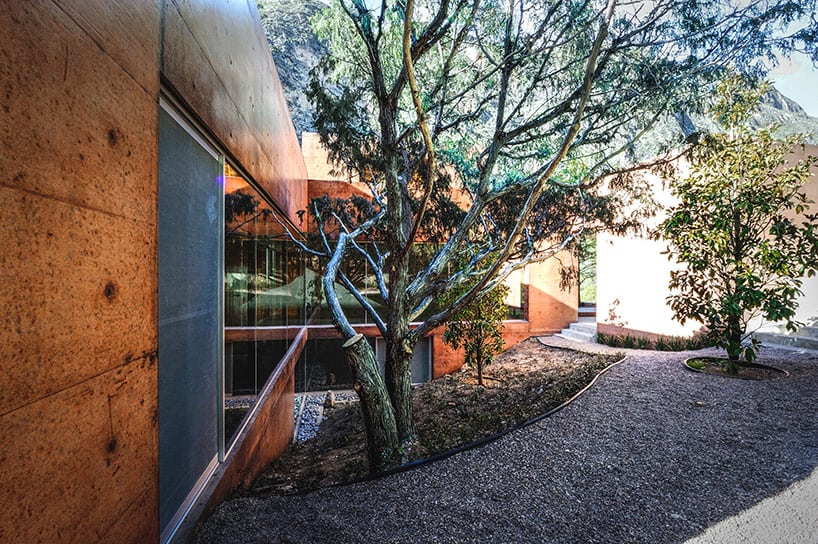
Within the corner-filled geometry of the house, a number of glass-walled spaces let light in while keeping privacy intact, bordered by enclosed garden areas of the property and by rock walls to one side.
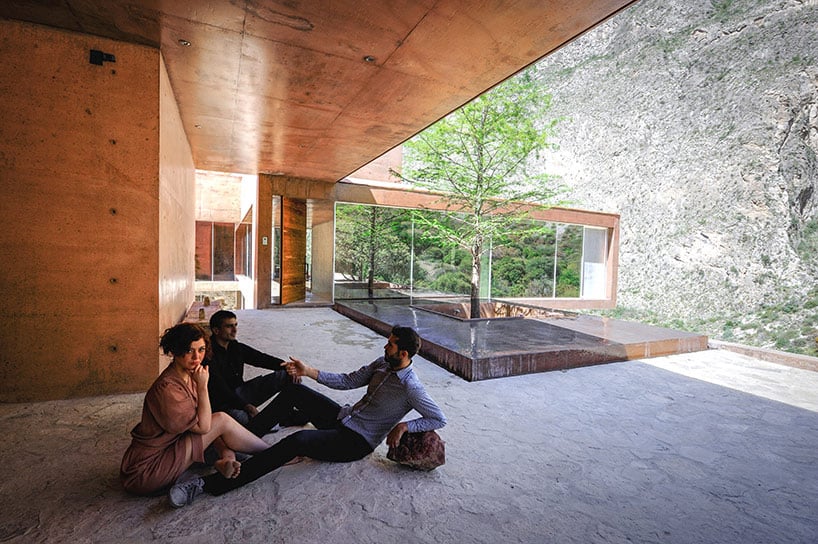
The entry courtyard, planted with a single young tree in the center of a wide stone plinth, is an open-air communal space bordered by a steep cliff face on its far side. The floor underfoot is rough-cut stone and the walls around are all rust colored, maximizing the contemporary house’s connection to the landscape.

At night, the reflection of nature off the entrance’s windows is replaced by an image of the rooms within, an entry foyer and the adjoining master suite, which is remarkably easy to access. Nighttime lighting also brings out the colors of wood on the front door, which are more vibrant than those of the concrete walls.

Throughout the property, a series of outdoor stairways hugs the edge of the abode, providing quick fair weather access to its most important rooms without having to trek through the interior.
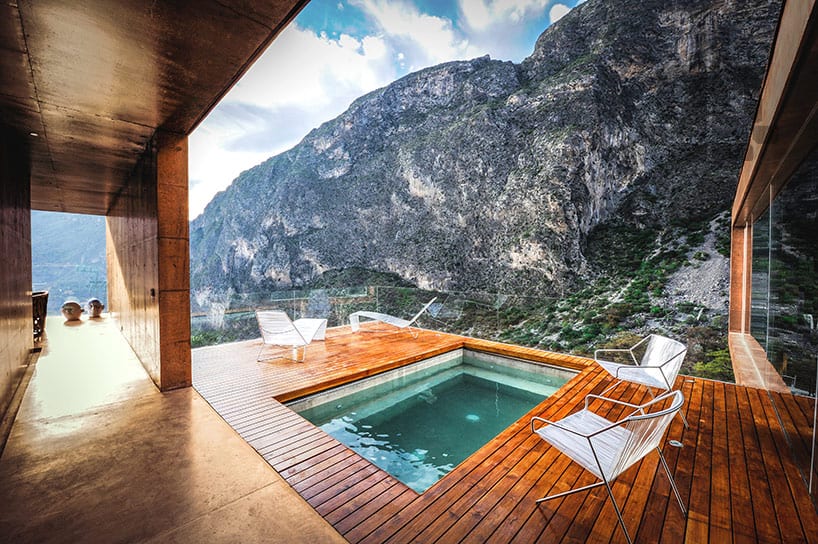
The deck at the rear outer corner of the house, complete with glass railings, features a small hot tub and wood decking, with access from the master suite and a number of public spaces.
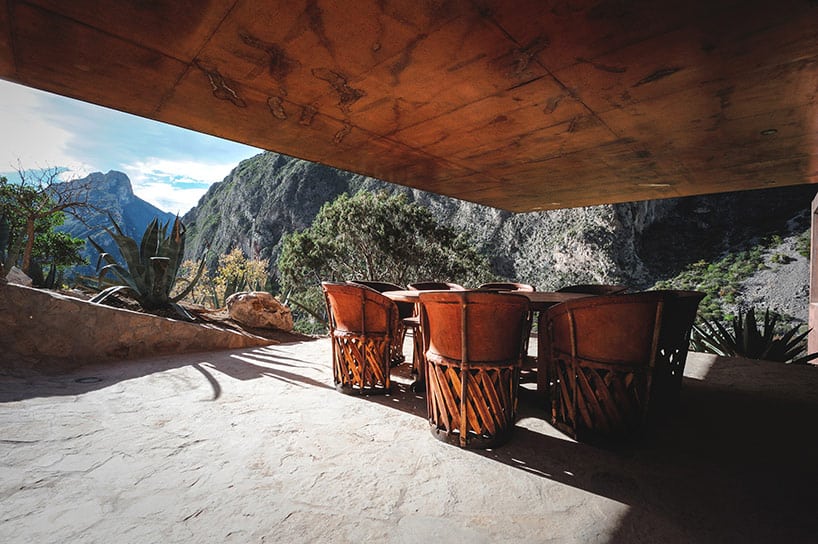
Underneath the impressively uncolumned bulk of the upper floors above, a casual outdoor dining area makes use of shade provided by this opening in the home’s architecture. On the edge of the space, spotlights in the floor frame the underside of the structure when darkness comes.
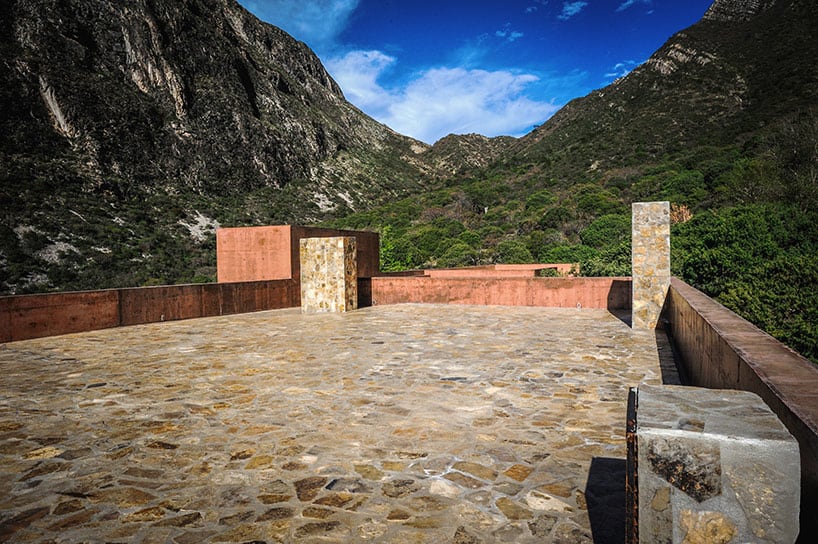
No piece of space is wasted in the house, with the stone patters of the dwelling’s driveway coming out once again to form the basis for a rooftop deck. While not currently populated with any furniture, the deck is large enough to host dozens of guests for any event.

The house’s walls are brought up beyond the roofline to delimit the deck, which can be accessed by three different stairways both indoors and out. It’s truly a space designed for personal use and large gatherings.

At one end of the deck, a chimney emerges from the living room, decorated with stone and wood finishes. Instead of being an eyesore on the rooftop, it’s a creative feature of the space.
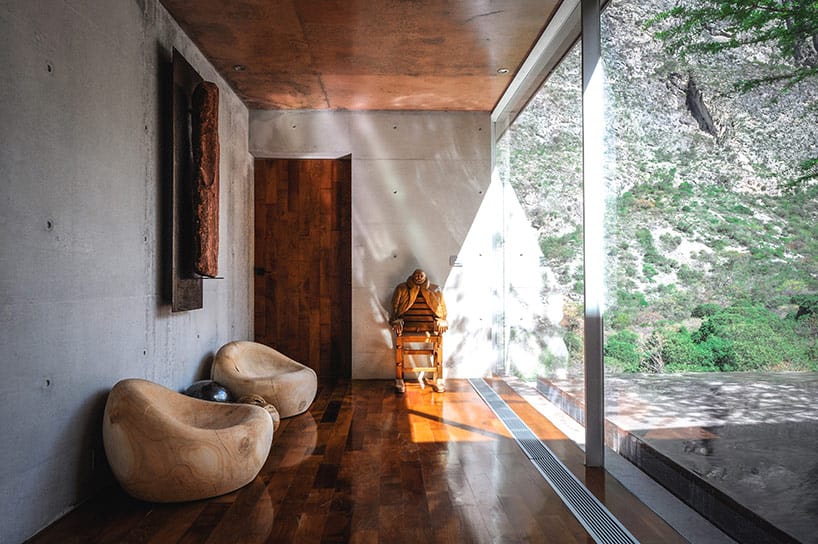
The seamless blend of modern shapes and traditional materials is continued inside, where the entry foyer is decorated with ergonomic wooden chairs and modern art pieces made from natural sources. Just steps away through the door at the end of the room, the cantilevered master suite is directly accessible.
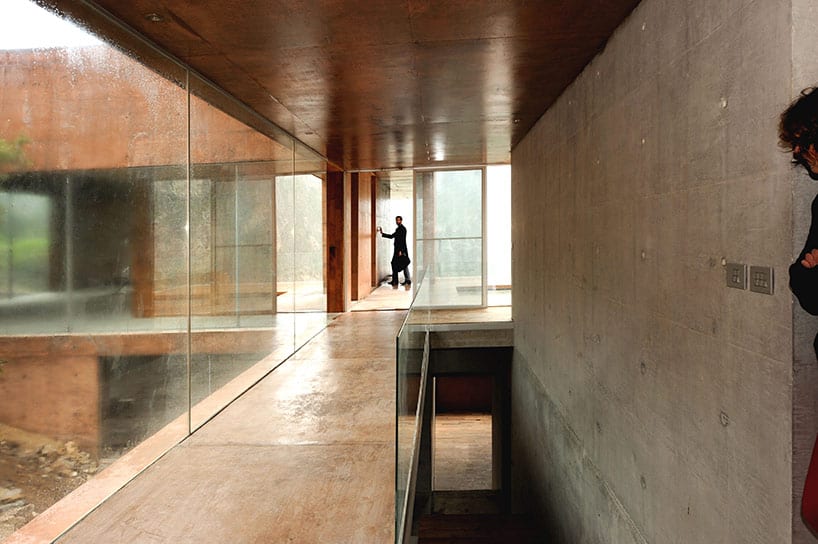
Upon entering, guests are given the choice of continuing forward to a four-way intersection in the hall, or to step immediately down a flight of low steps to the bottom level.
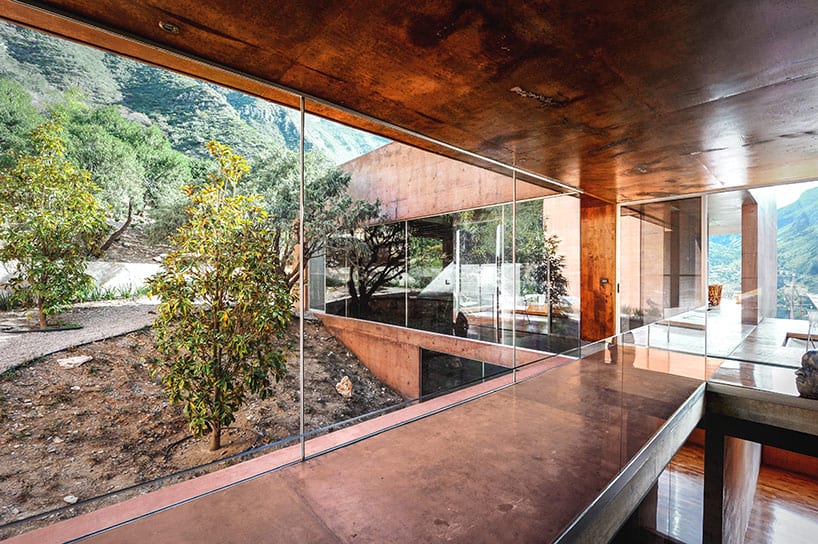
Every section of the hall is bordered by ceiling-height window walls, allowing an occupant or visitor to look out over the immediate lawn in one direction while viewing the mountains for miles in another. Overhead, the naturally worn tones of paint on the concrete are brought to the ceiling.
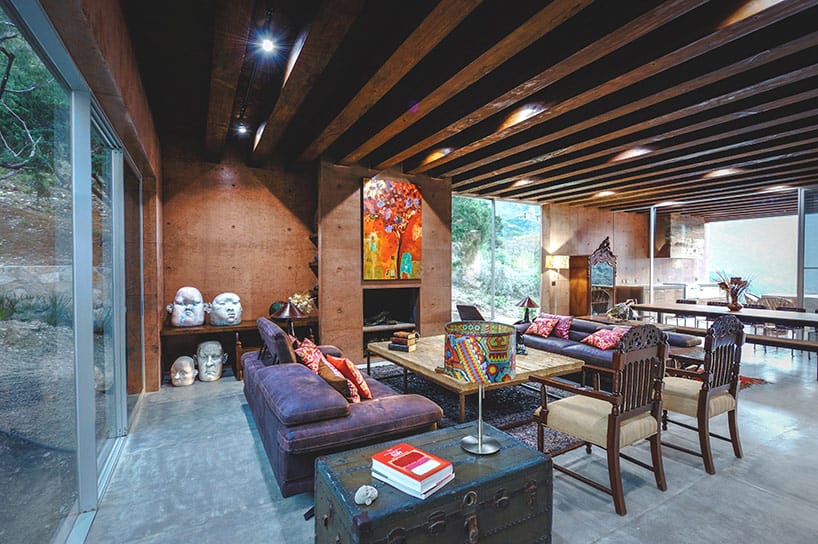
The main living room of the house is filled with uniquely traditional furnishings, with dark dominant tones set off by bright patterns of artwork, pillows, and other accent items. To avoid a boxed-in feeling, the floors underfoot are grey instead of the usual brown, and the ceiling here is punctuated by square timbers instead of a smooth concrete finish.
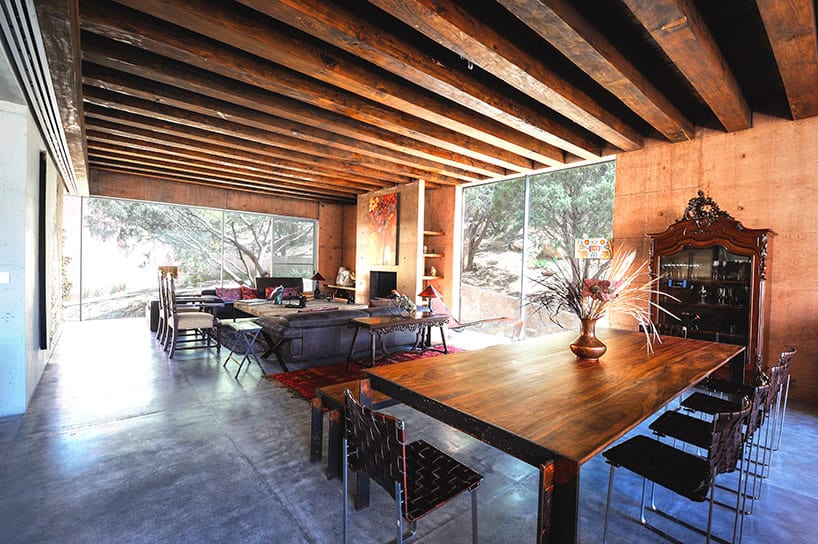
At the other end of the room, a dining table with seating for ten features some unique seating arrangements, with a bench along one edge and chairs made from woven cloth strips and a metal frame gracing the other edges. The table itself is constructed of the same wood seen on the doors and this room’s ceilings, continuing a theme of vibrant medium brown tones.

Easily the most conventionally contemporary section of the house, the kitchen eschews the dark wood and painted concrete of the rest of the house in favor of greyscale tones and stainless steel appliances. An island in the room’s center defines traffic flow and forms a casual eating space for four.
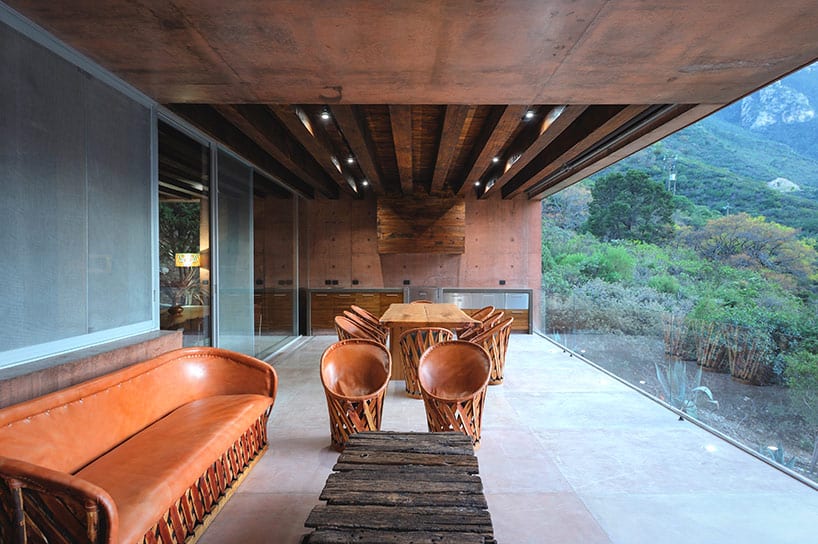
Beyond the kitchen and dining room, and additional living, cooking, and dining space reveals itself. This time the area is outside, set on the residence’s frontmost top-floor deck and filled with artistic wicker furnishings and an outdoor cooking area at one edge.
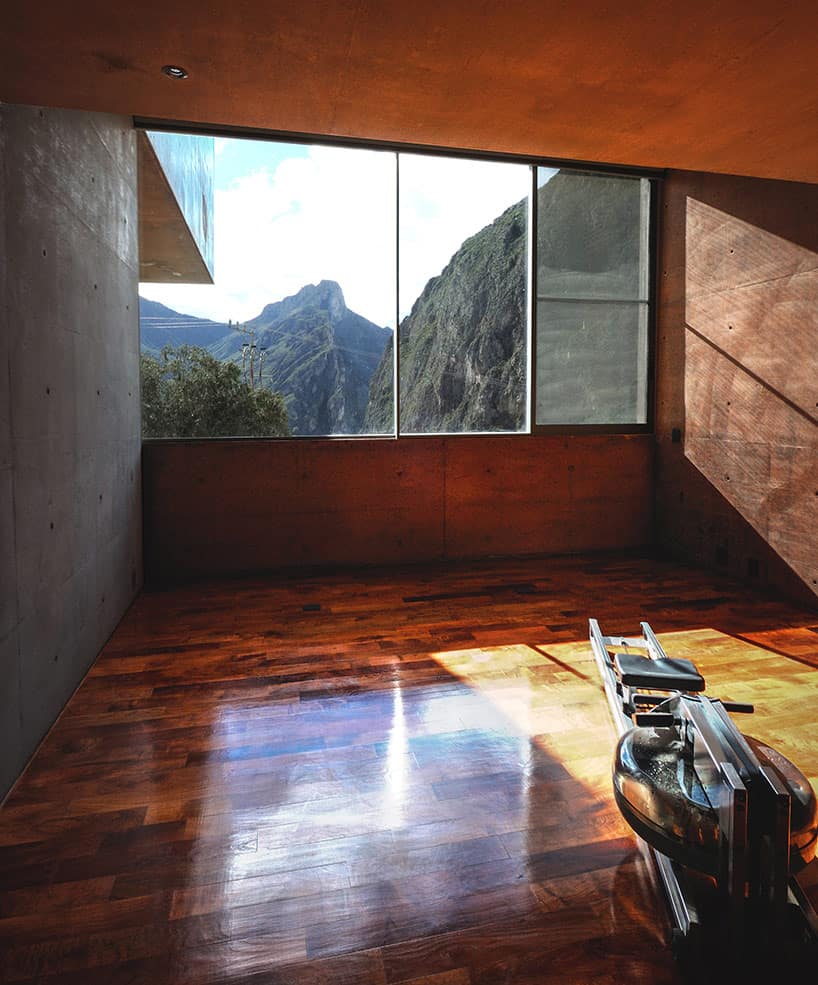
On the lowest floor of the house, a number of additional rooms make up the remaining bedrooms and private recreational spaces of the house.
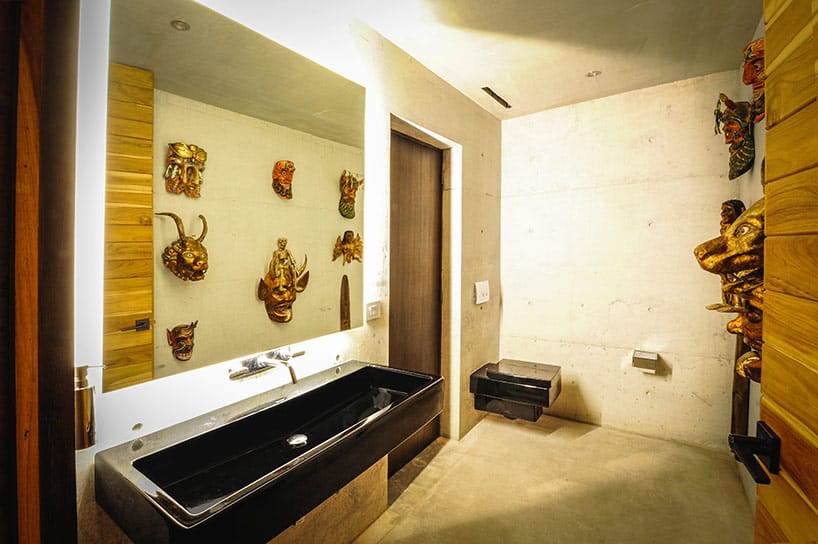
Every area of the house has a distinct personality. This bathroom, for example, is set apart by its unfinished concrete walls, gold accent tones, and gloss black fixtures.
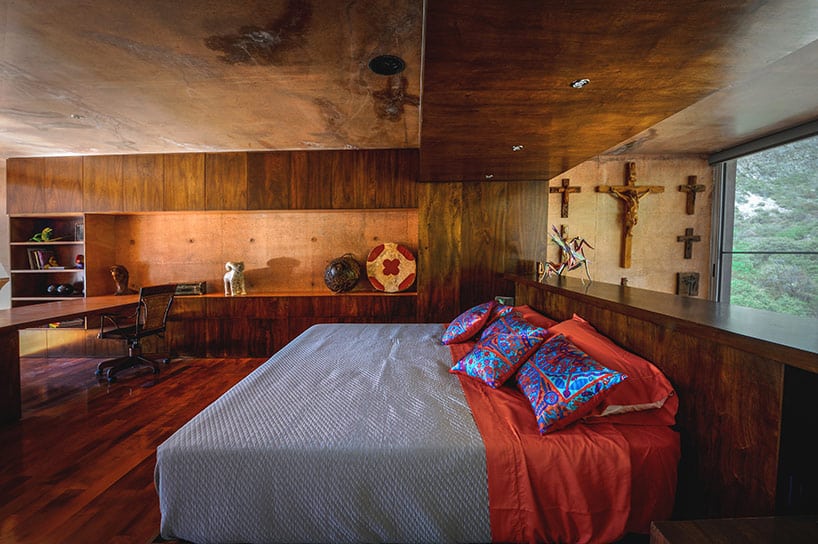
Back on the main floor, the master suite is the most personal and luxurious room of the house, set apart from the others and floating over the landscape with full window walls on either end. The suite features its own lounge area, office, and bathroom.
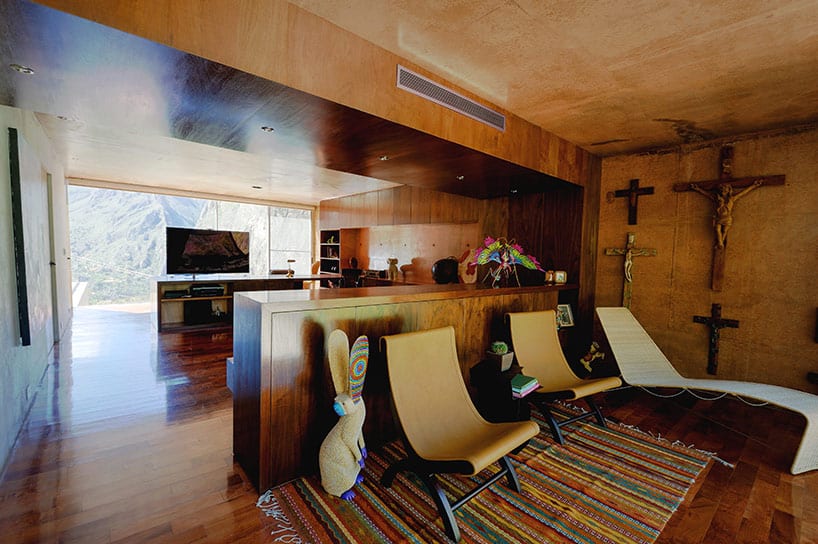
The master suite’s cabinetry forms a system built into the walls and ceilings of the space and forming separate areas within it, utilizing wood tones more than any other portion of the house.
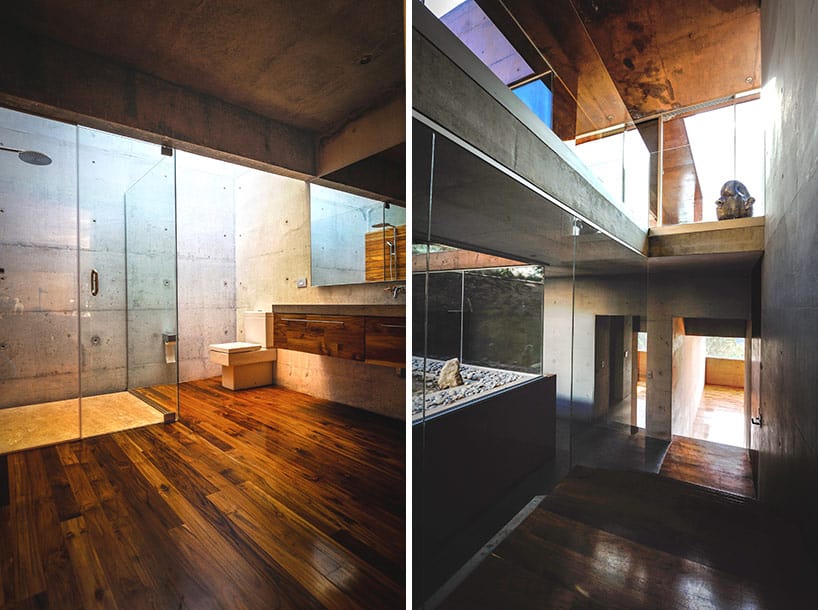
Turning convention on its head, most of the home’s bathrooms have wood flooring while its living room and dining room feature concrete. The juxtaposition of warm and cold tones in the master bathroom enhance the sense of space inside, while adding a touch of luxury.
P+0 Arquitectura
